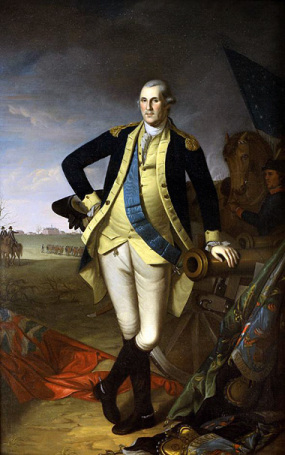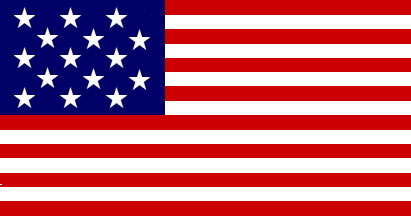Aardvark Antiques salutes the USA by celebrating this 4th of July with a montage of historical facts and photos. Hope you enjoy and God Bless the USA!
_________________________________________________________________________________
Born on February 22, 1732, George Washington was
raised in Westmoreland, Virginia and went on to inherit Mount Vernon and lived
there until death. When Washington was just 23 years old, he accompanied Major
General Edward Braddock in a failed attempt to drive the French from Ohio
Valley and was remembered for leading the British troops to safety when
Braddock was killed. However he became increasing resentful of the British
throughout his life. When the Revolutionary War broke out in 1775, Washington
was unanimously elected commander in chief of the Continental Army. Despite the
Americans’ wins and losses during the war, they came out victorious. Washington
was elected the 1st president of the United States of America in
1789. He served two terms and after refusing a third term, he returned to his
farm in Mount Vernon and there he died of a severe throat infection.

George Washington Andirons Here Washington is shown in uniform
Born in McIntosh County, Georgia, in 1823, John
McIntosh Kell entered the U.S. Navy in September 1841 as a Midshipman. Over the
next two decades he served in several ships, was active in California during
the war with Mexico, and participated in Commodore Matthew C. Perry's
expedition to Japan. When Georgia seceded from the Union in early 1861,
Lieutenant Kell resigned from the United States' Navy. In April 1861, he
briefly commanded the Georgia state gunboat Savannah, but received a
Confederate States Navy commission as First Lieutenant the following month and
was sent to New Orleans. There, he helped Commander Raphael Semmes fit out the
cruiser CSS Sumter. He served as Executive Officer during her commerce-raiding
cruise in 1861-62.
First Lieutenant Kell was Semmes' Executive Officer
on CSS Alabama throughout her career, and was present when she was sunk by USS
Kearsarge in June 1864. He was rescued by the British yacht Dearhound and taken
to England. Promoted to the rank of Commander in that month, he commanded the
ironclad CSS Richmond in the James River Squadron in 1865. After the end of the
Civil War, Kell returned to Georgia and became a farmer. In later years, he
served as Adjutant General of Georgia. John McIntosh Kell died in 1900.

Commander John McIntosh Kell Two Federal Period game tables once belonging to Commander Kell
in uniform.
Over the years, the flag that we cherish so has
changed. Here is a brief timeline of just how it has changed.

This is the Navy Jack flag from 1775 which is one of the
first colonial flags with 13
stripes. On it is a snake and the words “DON’T TREAD ON ME.”

This is the Grand Union flag, also from 1775. It has
13 stripes with a Union Jack in the
top left corner. This was the first flag of rebellion.

This is the Bennington Flag said to be carried at
the battle of Bennington. However many
experts doubt this story and date it from 1820-30. It has 13
stripes, a 76 in the top left corner that is surrounded by 13 stars.

This is the First National Flag of 1777. It was
adopted by congress as the first flag. It has 13
stripes and a circle of 13 stars.

The flag of 1795 has fifteen stars which represent
the thirteen colonies as well as Kentucky
and Vermont. The fifteen stars are presented in a 3/2 pattern.

Our current flag has 50 stars and 13 stripes and was adopted in 1860.
 |
|
Peter Early was born in Culpeper County, Virginia, on June 20, 1773, the eldest son of Lucy Smith and Joel Early. Early established a successful legal practice in Wilkes and Oglethorpe counties and by 1800 he had relocated to Greene County, where he built his own house on the western bank of the Oconee and became a leader of the local bar. He won a December 1802 special election to replace U.S. congressional representative John Milledge, who had resigned to become governor. Thus Early entered Congress a year earlier than he would have otherwise and took his seat in January 1803.
In 1807 he became a Supreme Court judge. In 1813 he became the governor of Georgia. He later worked with the founder of the University of Georgia as a trustee. By 1816 he had become the university's senior trustee, and after directing the search for a new college president, he was designated college "president pro tempore" for the winter and spring of 1817, until the new president, the Reverend Robert Finley, could move to Georgia. Not long after Finley arrived, Early became ill and died on August 15, 1817. |

Georgia Land Warrant signed and stamped Peter Early Governor of Georgia 1773-1817
Henry Lee III, also
known as Light-Horse Harry, was born on January 29, 1756. He fought in the
Revolutionary War and was in charge of a mixed corps of cavalry and infantry
known as Lee’s Legion. It was during his time as commander of the Legion that
Lee earned the sobriquet of "Light-Horse Harry" for his horsemanship.
His son Robert E. Lee was born in 1807 and went on to play an important role in
the Confederate Army during the civil war. Henry Lee was a major general in the
U.S. Army in 1798–1800. From 1799 to 1801, he served in the United States House
of Representatives of the Congress. A new county of Virginia was named after
him during his governorship. He died on July 27, 1812. Lee received grave injuries
while helping to resist an attack on his friend, Alexander Contee Hanson,
editor of the Baltimore newspaper, The Federal Republican. Hanson was attacked
by Democratic-Republican mob because his paper opposed the War of 1812.
 |
| This Georgia land grant is signed by Governor Henry Lee (Father of Robert E. Lee). |
Henry Lighthorse Lee Governor of Virginia 1791-1794
Benjamin Paschall was born in June of 1690 in Bristol England, the son of Joseph and Mary Wickham Paschall. That Benjamin married the widow, Mary Say, is well known from the Say Bible and their wills and the book of Dr. Benjamin Say. Benjamin was quite a bit younger than his wife was. It is likely that Benjamin was well loved by his stepson, Thomas Say, as he named his son Benjamin. Indeed, it would seem likely that all the subsequent Paschalls named Benjamin derive from him. Strangely, Benjamin never sold any property, only purchased. At death, he seemed to be insolvent. Mary wrote in her Bible that Benjamin died the 16th of May 1730, and was buried, “in his own burial ground.” Later documents (1875) show that the burial ground was 40x36 feet. The land when purchased in 1724 was 40x198 so some of the property was otherwise in use. When Mary died in 1734, her son Thomas Say wrote that she was buried “beside her husband in our own burial ground.” This was the 3rd St cemetery where Benjamin was buried, since this now belonged to Thomas and would be referred to in that manner by him. Later, Thomas Say and his son were buried there along with their children.
1832 Georgia Land Grant Signed Stamped by Governor Charles McDonald (Governor Of Georgia 1839-1843)
This official document is partly printed on vellum, a land grant for 160 acres in Cherokee County. Eight times between 1805 and 1833 Georgia held lotteries to distribute land, the largest held in the United States. The original Cherokee Indian territory became Cherokee County by an Act of December 26, 1831. A law passed on December 3, 1832, and divided original Cherokee County into ten counties. Surveyed on May 23, 1832 by Samuel Bailey.
Picturesque America is a two-volume set of books
describing and illustrating the sites of America. Published by D. Appleton and
Company of New York in 1872 and 1874, it was edited by William Cullen Bryant.
This set is in very good condition with wear to the edges and corners as the
leather covers have dried out over time. Each volume measures 2.5"D x
10.5"W x 13"H.
The work's essays together with its nine hundred
wood engravings and fifty steel engravings, are considered to have had a
profound influence on the growth of tourism and the historic preservation
movement in the United States. This two-volume set and others of the same genre
achieved great popularity in the nineteenth century. Their illustrations
provided a tour of nineteenth century America.

The volumes display both steel and wood engravings based on the paintings of some of the best American landscape painters of the nineteenth century. Such as John Frederick Kensett, William Stanley Haseltine, James David Smillie, John William Casilear, Thomas Moran, A. C. Warren, Harry Fenn, David Johnson, Granville Perkins, John Douglas Woodward (1846-1924), Felix Octavius Carr Darley, Albert Fitch Bellows, James McDougal Hart, Casimir Clayton Griswold (1834-1918), Worthington Whittredge, Charles G. Rosenberg (1818 - 1879), William Ludwell Sheppard (1833-1912), Homer Dodge Martin, Alfred Rudolph Waud, William Hart, Robert Swain Gifford, Jules Tavernier, William Hamilton Gibson, Thomas Cole and others
Images originally published in Picturesque America 1872
ORIGINAL FIRST ISSUE of LIFE Magazine was published
November 23, 1936, Fort Peck Dam, Montana Cover taken by Margaret Bourke-White. Photos by Margaret Bourke-White, Alfred Eisenstaedt, Thos.
D. McAvoy, Peter Stackpole Art: Artist John Steuart Curry of Kansas, complete
with 5 great large color illustrations of his paintings. Franklin Roosevelt's
Wild West Chinatown School Fort Knox Cheerleaders War Stories
Movie:"Camille" Russia Gooney Golf Hollywood parties Picture: Fort
Belvedere Pictorial: Brazil NBC Radio Studios, "... Celebrating 10th
birthday last week" Pictorial Profile: Helen Hayes Montana Relief Workers
daily life. Vintage Ads, full page color ads for General Motors Cars, a
double-page full color ad for Chessie - the Chesapeake and Ohio Railroad, and
other great 30's industry and product ads.

The New York Journal-American was a newspaper
published from 1937-1966. This particular article which we have for sale is on
the assassination of President Kennedy. Kennedy was assassinated in Dallas,
Texas at 12:30 pm on November 22, 1963. He was shot by Lee Harvey Oswald.
Kennedy was also in the car with his wife, and the Governor Connally of Texas.  Connally was wounded
but not fatally.
Connally was wounded
but not fatally.
 Connally was wounded
but not fatally.
Connally was wounded
but not fatally.
Jan
H. Kemp (March 1949 - December 2008) was an American academic and
English tutor who exposed the bias in passing college football players
and filed a lawsuit against the University of Georgia.
Jesse
Jackson (born October 8, 1941) is an American civil rights activist and
Baptist minister. He was a candidate for the Democratic presidential
nomination in 1984 and 1988 and served as a shadow U.S. Senator for the
District of Columbia from 1991 to 1997.
Harry Hines Woodring
(May 1890 – September 1967) was the twenty-fifth governor of Kansas, and
Secretary of War in President Franklin Delano Roosevelt's Cabinet.
Alexander
Meigs Haig, Jr. was a United States Army general who served as the
United States Secretary of State under President Ronald Reagan and White
House Chief of Staff under Presidents Richard Nixon and Gerald Ford.
Hubert
H. Humphrey was the 38th Vice President of the United States, serving
during Lyndon Johnson's administration from 1965 to 1969.
John Forsyth was a 19th
century American politician from Georgia. He was Secretary of State
under Andrew Jackson's administration, appointed in 1834.















No comments:
Post a Comment